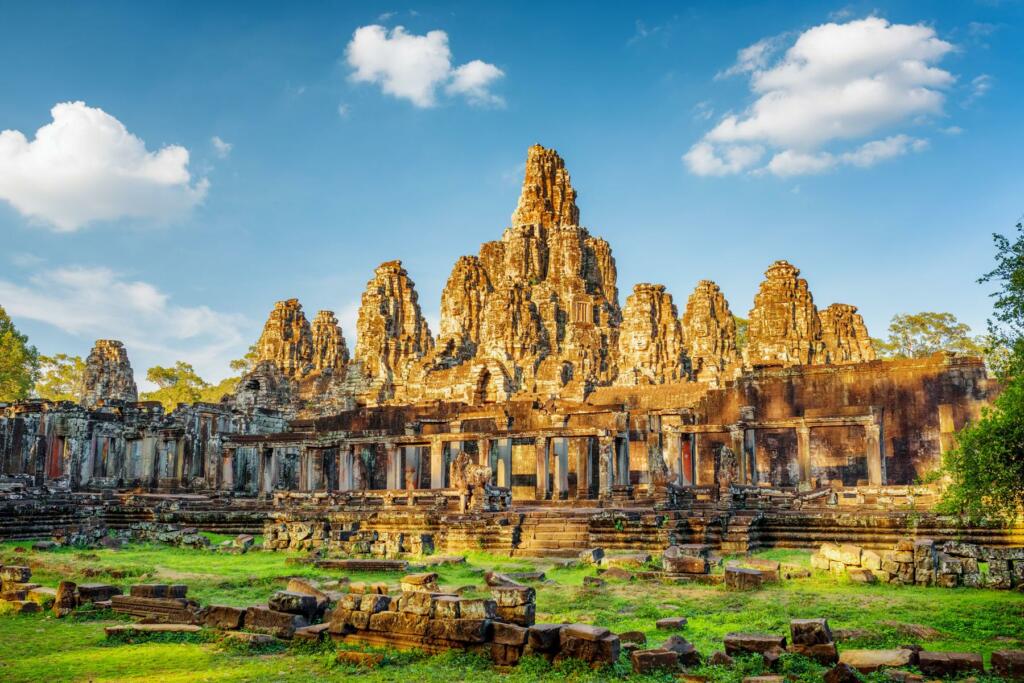One might have heard about Cambodia for housing the largest Hindu temple compounds on the planet. But, not many would be aware of the fact that the southeast Asian country has had a rich history of Hindu rulers with Hinduism deeply entrenched into the beliefs of Buddhists who are in majority.
Currently, the total population of Cambodia is 16.7 million, out of which approximately 95 per cent of the population is Buddhist, with the majority practising Theravada Buddhism. Cham Muslims, Christians, and tribal animists make up for the remaining numbers.
However, Cambodia’s connection with Hinduism can be traced back to the Funan Kingdom reigning between 100BC and 500AD. Hinduism was one of the Khmer Empire’s official religions.
The local folklore tells a story about a romantic affair between the queen of the Apsaras (heavenly Nymphs) named Mera and a Cambodian king named Kambu whose progeny became the Khmers.
During this period, kings worshipped Vishnu and Shiva. When the Khmer Empire came to power, Hinduism remained the dominating religion until Jayavarman VII (reigned 1181-1218).
Similar traditions of Khmer’s to that of Indian Hindus
Khmer people, too, believe in reincarnation much like the Hindus. Traditional marriages involve the matching of horoscopes just like traditional Hindu marriages. After death, the body is cremated; a part of the ashes is immersed in the river and the rest is kept inside a stupa.
Historical evidence suggests that one of the most important religious festivals of the Khmer people was Pchum Ben, which is still celebrated widely. The festival lasts for 15 days, culminating in celebrations on the 15th day of the tenth month in the Khmer calendar, at the end of the Buddhist Lent, Vassa.
Shraddha season and the uncanny similarity
During this period, offerings of balls of rice mixed with sesame seeds are made. It is believed that during this period, the spirits of ancestors of seven generations descend on earth. It is somewhat reminiscent of the ‘Pitru Paksh’ that is observed here in India
Every year, the Shraadh ritual is performed on the death anniversary of a person during the Amavasya called ‘Pitru Paksha’. It is a custom for the Hindu religion, also called Mahalayapitru paksha, which begins at Purnima in the Ashwini month.
Read More: Why every Hindu must observe the Shraadh season
The Angkor Wat and its restoration
The deep cultural ties between India and Cambodia means there are several monuments, designated as UNESCO World Heritage Sites in the region which reflect the influence of Indian culture in Southeast Asian countries. India has on its part, helped in the restoration and conservation of several such monuments which extends beyond the Indian territorial boundary.
One such example is the Angkor Wat, the centre of the Khmer Kingdom in Cambodia which India has recently helped restore. In the year 1980, Cambodia had appealed to the world community to help save the Angkor Wat, which India was the first country to respond to.
The Angkor Wat temple was constructed as a Hindu temple and is dedicated to Lord Vishnu. The walls of the temple are covered with extraordinary carvings depicting stories and characters from the Mahabharata, Ramayana and include hundreds of fine carvings of Apsaras.
The design of Angkor Wat simulates a representation of Mount Meru, the centre of the universe and the abode of the gods, surrounded by mountain ranges and oceans. The origins of this design can be traced to many of the temples of India.
Read More: India is working to revive the ancient temples in Southeast Asia
Other Hindu temples
It’s not only the Angkor Wat where India has stepped up to work with the Cambodian government to preserve the legacy of Hinduism. As reported by TFI, ASI is currently working on the restoration and conservation of the Ta Prohm temple, commonly known as the Tree Temple.
It is a significant 12th-century monastic Buddhist temple complex located in the Angkor World Heritage Site. The temple had featured in the movie Lara Croft: Tomb Raider and since then shot to its popularity. As of now, it is the second most popular tourist site in Cambodia after the Angkor Wat Temple.’
Apart from India, various versions of Ramayana are found across the world. Cambodia is no different as its iteration of Ramayana is called Reamker. The story is more or less the same but slight modifications are made to tailor it to the local audience.
Read More: Shri Ram is not confined only to North India, Shri Ram is everywhere
It is interesting to note that while Buddhism and Hinduism both originated in India, they have had different journeys in Indian and Cambodia. While Buddhism was reduced to a minority by the 12th century in India, the opposite happened in southeast Asia. In Cambodia for instance, Hinduism had virtually disappeared by the 14th century.
India’s engagement with Southeast Asia has increased after the Modi government came to power. PM Modi has repeatedly emphasized the cultural ties of India and Southeast Asia. As such, further co-operation in the revival of cultural monuments have picked up speed under the Modi government and the trend is likely to continue.
Hindus may not be present in bigger numbers in Cambodia anymore but their legacy through architecture and culture continues to influence the soul of the southeast Asian country.
